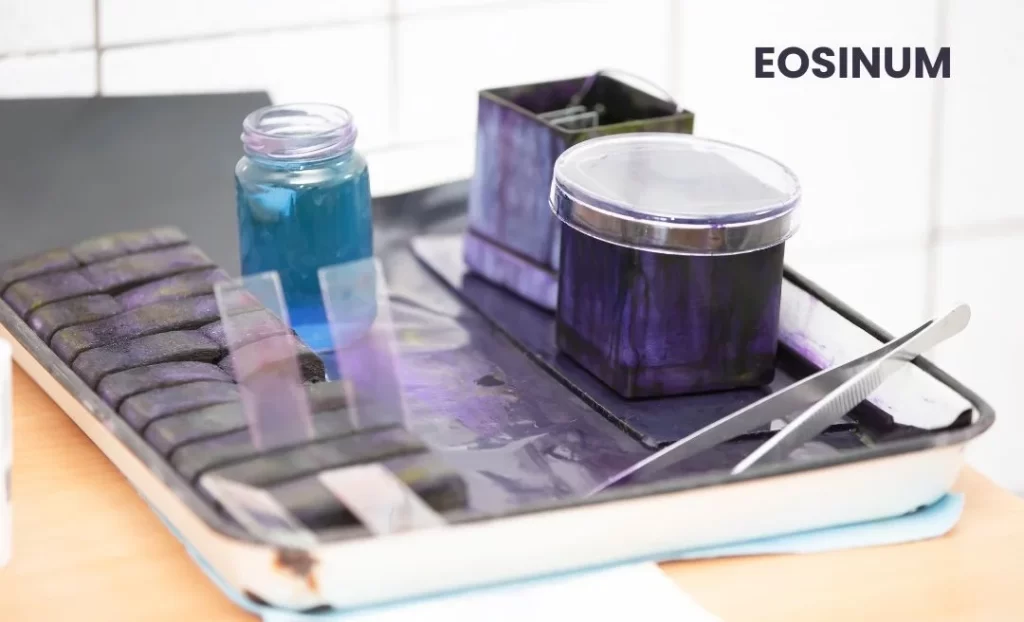Eosinum, commonly known as Eosin, is a homeopathic remedy known for its effectiveness in treating conditions such as cancer and polyarthritis.
It was proved in potencies by Dr. B. C. Woodbury.
Eosin is traditionally used in histology for staining tissues but has shown promise in homeopathic applications for its therapeutic effects.

Table of Contents
ToggleDETAILED SOURCE INFORMATION
Scientific Classification
- Chemical Name: Eosin Y (also known as Eosin YS, Acid Red 87, or Bromoeosine)
- Chemical Formula: C₂0H₈Br₄O₅
- CAS Number: 17372-87-1
Origin and Historical Facts
- Synthesis and Discovery: Eosin was first synthesized by Heinrich Caro, a German chemist, in 1871. It is derived from fluorescein by bromination, making it a brominated derivative of fluorescein.
- Chemical Properties: Eosin is a fluorescent acidic dye that belongs to the xanthene class of dyes. It is known for its ability to stain cytoplasm, collagen, and muscle fibers red in histological applications.
- Applications in Science: Historically, Eosin has been widely used in histology and pathology to highlight cell structures in tissues.
- It is commonly used in combination with hematoxylin in the H&E (Hematoxylin and Eosin) staining method, which is a principal stain in medical diagnostics.
- Historical Use in Medicine: In homeopathy, Eosin (referred to as Eosinum) was introduced and proved by Dr. B. C. Woodbury.
- It has been employed in treating specific conditions such as cancer and polyarthritis, leveraging its observed effects on the skin and mucous membranes.
Chemical and Physical Properties
- Appearance: Eosin Y appears as a reddish or pink powder.
- Solubility: Soluble in water and alcohol, it is typically used in a 1% aqueous solution for histological staining.
- Molecular Weight: 647.89 g/mol
DRUG PATHOGENESIS
- Eosinum’s pathogenesis involves its action on various parts of the body, particularly the skin and mucous membranes.
- It demonstrates significant effects in treating symptoms associated with cancer and inflammatory joint conditions.
KEY CHARACTERISTICS
SKIN AND NAILS
- Burning Sensation: Notable burning sensation under the fingernails and toenails.
- Soles: Burning sensation on the soles of the feet.
- Redness and Itching: Particularly around the knee-caps, often accompanied by redness.
- Redness of Palms: The palms of the hands exhibit redness.
TONGUE
- Burning and Numbness: The tongue experiences burning and numbness.
- Redness: Increased redness of the tongue.
GENERAL SENSATION
- Vertigo and Peculiar Sensation: A peculiar sensation of being very tall accompanied by a tendency towards vertigo.
MODALITIES
- Worse: The symptoms, particularly burning sensations, are often aggravated by movement or pressure.
- Better: Scratching provides temporary relief for burning sensations.
RELATIONSHIP WITH OTHER DRUGS
Compare with,
- Arsenicum Album: For its burning pains and restless anxiety.
- Sulphur: For its itching and burning sensations, especially on the skin.
- Apis Mellifica: For its red, swollen, and burning sensations.
DOSE
- Second Decimal Potency (1% Solution): Eosinum is commonly administered in the second decimal potency for its therapeutic effects. This corresponds to a 1% solution.
Frequently Asked Questions (FAQs)
What is Eosinum used for?
- Eosinum is used in homeopathy for treating symptoms associated with cancer and polyarthritis, particularly those involving burning sensations and redness in various parts of the body.
How is Eosinum prepared?
- Eosinum is prepared in homeopathic potencies through serial dilution and succussion, with the second decimal potency being commonly used.
What are the primary symptoms treated by Eosinum?
- Eosinum primarily treats burning sensations under the nails, on the soles, redness of the palms and tongue, and itching around the knee-caps.
Glossary of Difficult Words
- Proved: Tested in homeopathic provings to determine the effects and symptoms produced by a substance.
- Polyarthritis: A condition involving inflammation of multiple joints.
- Decimal Potency: A method of homeopathic preparation where a substance is diluted in a ratio of 1 part substance to 9 parts diluent.
- Histology: The study of the microscopic structure of tissues.
- Fluorescein: A synthetic organic compound used as a dye.
- Succussion: The process of shaking a homeopathic preparation to enhance its therapeutic potency.
